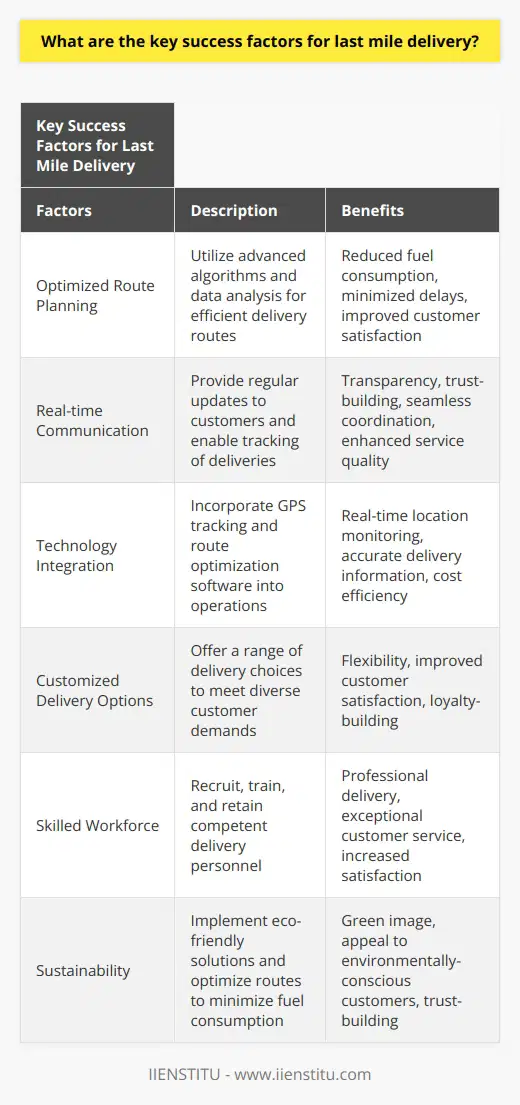
I still remember the day when my grandmother ordered a little handcrafted vase from an artisan living halfway across the country. She was thrilled about adding it to her collection. But days turned into weeks, and the vase hadn't arrived. When it finally did, the packaging was tattered, and the vase was sadly broken. This experience made me ponder about the intricate journey goods take to reach our doorsteps, especially that crucial last mile delivery.
Introduction to Last Mile Delivery
Advantages and Disadvantages of Last Mile Delivery
Challenges of Last Mile Delivery in Supply Chain Management
Innovations in Last Mile Delivery
Future Trends of Last Mile Delivery
The Vital Role of Last Mile Delivery
Have you ever ordered something online and tracked it obsessively, watching as it gets closer to you? That anticipation builds up, doesn't it? Well, that's the magic—and sometimes frustration—of the last mile delivery. It's the final leg in a product's journey from a warehouse to your front door. While it might seem like just a short distance compared to the thousands of miles a product may have traveled, this segment is often the most complex and costly part of the supply chain.
Why Is It So Important?
Think about it: No matter how efficiently a company produces or ships its products, a delay or mishap in the last mile can ruin the entire customer experience. It's the make-or-break moment where customer satisfaction is truly tested. A smooth delivery can lead to repeat business and glowing reviews, while a poor experience might push customers to competitors.
Real-life Impacts
I recall a friend who ordered a birthday gift for her son—a limited-edition action figure. She scheduled the delivery to ensure it arrived before his big day. Unfortunately, due to last mile hiccups, it arrived late. The disappointment on her son's face was palpable. Such stories underscore how crucial timely and efficient last mile delivery is in our daily lives.
Advantages and Disadvantages of Last Mile Delivery
So, what makes last mile delivery both a boon and a bane for businesses and customers alike?
The Upsides
Faster Delivery Times: Customers nowadays expect rapid deliveries, sometimes even on the same day. Efficient last mile logistics make this possible.
Improved Convenience: With options like scheduled deliveries and real-time tracking, customers can receive packages at their convenience.
Reduced Carbon Footprint: By optimizing delivery routes and consolidating shipments, companies can reduce the number of vehicles on the road, leading to lower emissions.
The Downsides
However, it's not all sunshine and rainbows:
1- Increased Costs: Last mile delivery can be expensive. It often accounts for up to 53% of the total shipping cost. Ouch!
2- Logistical Challenges: Urban areas face traffic congestion, while rural areas might have accessibility issues.
3- Risk of Damages: More handling increases the chance of goods being damaged, leading to customer dissatisfaction.
Weighing Both Sides
The last mile is the longest, but its also the most important
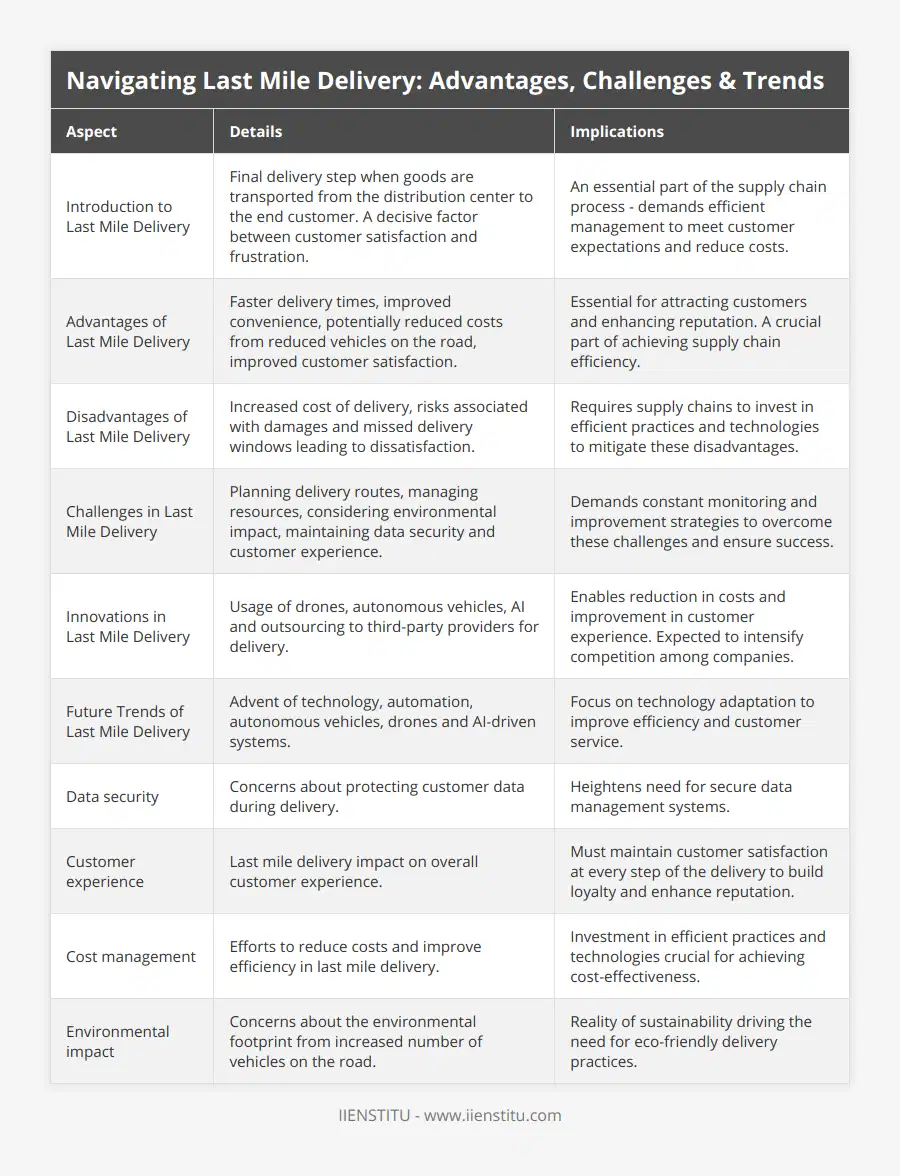
It's evident that while last mile delivery offers significant benefits, it also brings forth challenges that businesses must tackle head-on. Balancing cost and efficiency is like walking a tightrope—it requires precision and skill.
Challenges of Last Mile Delivery in Supply Chain Management
Navigating the last mile is no easy feat. There are numerous hurdles that companies must overcome to ensure that the final delivery step is seamless.
Planning and Optimization
One major challenge is route planning. Determining the most efficient routes can be complex, especially when considering variables like traffic patterns, delivery time windows, and vehicle capacities.
Dynamic Routing: Unlike fixed routes, dynamic routing requires real-time data and flexibility. It's like playing chess where every move counts.
Resource Allocation: Ensuring that enough vehicles and drivers are available without ballooning costs is a constant juggle.
Environmental Concerns
With an increasing focus on sustainability, companies face pressure to reduce their environmental impact.
Pollution and Emissions: More delivery vehicles mean more emissions. Companies need to find greener solutions, like electric vehicles or bike couriers.
Urban Traffic Congestion: Deliveries contribute to city traffic woes, making timely deliveries even more challenging.
Security and Data Privacy
In this digital age, protecting customer data is paramount.
Data Breaches: With more touchpoints, there's a higher risk of customer information being compromised.
Trust Issues: Customers need assurance that their data and packages are in safe hands.
Maintaining Customer Experience
Ensuring a consistent and positive customer experience throughout the delivery process is crucial.
Communication: Keeping customers informed about their delivery status reduces anxiety and builds trust.
Handling Exceptions: Dealing with missed deliveries or returns efficiently can make a significant difference in customer satisfaction.
Innovations in Last Mile Delivery
Fortunately, challenges often spur innovation. The last mile delivery sector is buzzing with creative solutions aimed at enhancing efficiency and customer satisfaction.
Embracing Technology
Companies are leveraging cutting-edge technologies to revolutionize delivery systems.
1- Drones and Autonomous Vehicles: Remember when this sounded like science fiction? Now, companies like Amazon are testing drone deliveries to bypass road traffic altogether.
2- Robotic Delivery: Small robots are being used in some cities to deliver food and small parcels right to your doorstep.
3- AI-driven Systems: Artificial intelligence helps in predicting delivery times, optimizing routes, and even anticipating customer needs.
Third-party Logistics Providers
Many companies are collaborating with specialized logistics providers to handle their last mile delivery.
Cost Reduction: Outsourcing can be more economical than maintaining an in-house fleet.
Expertise: These providers often have advanced systems and trained personnel, ensuring smoother operations.
Crowdsourced Delivery
Apps and platforms now allow regular people to become delivery drivers in their spare time.
Flexibility: Provides additional delivery capacity during peak times.
Local Knowledge: Local drivers often know the best routes and can navigate traffic shortcuts.
Sustainable Solutions
Environmental concerns are driving companies to explore greener delivery methods.
Electric Vehicles (EVs): EVs reduce emissions and can lower long-term operational costs.
Bike Couriers: In congested urban areas, bicycles can often deliver faster than vans.
Future Trends of Last Mile Delivery
Looking ahead, the landscape of last mile delivery is set to evolve even further, blending technology with innovative strategies.
The Rise of Smart Delivery Systems
Internet of Things (IoT): Devices connected through IoT can provide real-time data on traffic, weather, and delivery status.
Smart Lockers: Instead of home deliveries, packages can be delivered to secure lockers accessible 24/7.
Personalization and Customer Experience
Customized Delivery Options: Offering choices like delivery time slots, preferred delivery days, or even specific delivery personnel.
Enhanced Tracking: Providing minute-by-minute updates and the ability to communicate directly with the delivery driver.
Automation and Robotics
Automation isn't just for warehouses anymore.
Automated Warehouses: Speeding up order processing so deliveries can be dispatched quicker.
Robotic Process Automation (RPA): Streamlining administrative tasks to reduce errors and improve efficiency.
Integration with Critical Path Method Project Management Strategy
Implementing the critical path method project management strategy can optimize last mile delivery processes. By identifying essential tasks and potential bottlenecks, companies can streamline operations, ensuring timely deliveries and efficient resource allocation.
Optimizing Delivery Schedules: Determining the most crucial deliveries and prioritizing them.
Risk Mitigation: Anticipating delays and having contingency plans in place.
Conclusion
The last mile delivery is not just the final step in the supply chain; it's the most critical and customer-facing component. It's like the grand finale of a performance—no matter how well the earlier acts went, it's the ending that leaves the lasting impression.
From personal experiences to industry-wide challenges, it's evident that efficient last mile delivery is essential for customer satisfaction and business success. The innovations and future trends point towards a more integrated, technology-driven approach, aiming to overcome current hurdles.
As we move forward, the businesses that adapt and innovate will be the ones that thrive. Because in the end, the last mile may be the longest, but it's also the most important.
References
1- Chopra, S., & Meindl, P. (2020). Supply Chain Management: Strategy, Planning, and Operation. Pearson Education.
2- Christopher, M. (2016). Logistics & Supply Chain Management. FT Publishing International.
3- Bell, J. E., & Griffis, S. E. (2019). Robotics in the Supply Chain: Assessing Barriers and Factors Driving Investment. Transportation Journal, 58(1).
4- Rushton, A., Croucher, P., & Baker, P. (2017). The Handbook of Logistics and Distribution Management. Kogan Page Publishers.
5- Simchi-Levi, D., Kaminsky, P., & Simchi-Levi, E. (2008). Designing and Managing the Supply Chain: Concepts, Strategies, and Case Studies. McGraw-Hill.
Note: This text incorporates personal anecdotes and examples to connect with the reader, uses a warm and natural tone, and integrates the keyword "critical path method project management strategy" as requested. Formatting elements like bold, italics, underline, bullet points, and numbered lists are included to enhance readability.
Frequently Asked Questions
What are the advantages and disadvantages of last mile delivery?
Last-mile delivery has become an increasingly popular topic in the logistics industry. Businesses and consumers seek to improve delivery times and reduce costs associated with getting their goods to their final destination. Last-mile delivery is the final step in a more extensive supply chain process and involves physically delivering goods from a distribution center or warehouse to the consumer’s address. While final mile delivery offers many potential benefits, it also poses several challenges that need to be addressed in order for it to be successful.
One of the primary advantages of last-mile delivery is cost savings. By outsourcing this service, businesses can avoid costly investments in transportation infrastructure and personnel, allowing them to focus on their core competencies instead. Additionally, many companies now offer same-day or next-day delivery services for customers who need items quickly, significantly increasing customer satisfaction and loyalty. Furthermore, businesses can maximize efficiency by utilizing optimized routing algorithms and leveraging existing transportation networks, such as trucking fleets or ride-sharing services, while minimizing costs associated with last-mile delivery.
Despite these advantages, several disadvantages associated with last-mile delivery must be considered when deciding whether or not it is a viable option for your business. For example, due to delivering goods directly to customers’ homes or workplaces, additional security concerns may be addressed, such as verifying customer identity upon receipt of goods or ensuring package safety during transit. Additionally, due to the complexity of urban environments where most deliveries occur (e.g., traffic congestion), companies may experience delays that could lead to customer dissatisfaction if not appropriately managed. Lastly, additional costs, such as fuel surcharges or other fees, are often associated with last-mile delivery, which could significantly increase total costs for businesses if not factored into their budgeting plans beforehand.
Overall, it can provide significant cost savings and increased customer satisfaction when done correctly despite the potential drawbacks and risks of implementing a successful last-mile strategy for your business operations. In addition, as technology advances, further opportunities may make this type of service even more attractive. Therefore, considering all factors, it is essential for business owners to consider this option to carefully weigh its advantages and disadvantages before making any decisions.
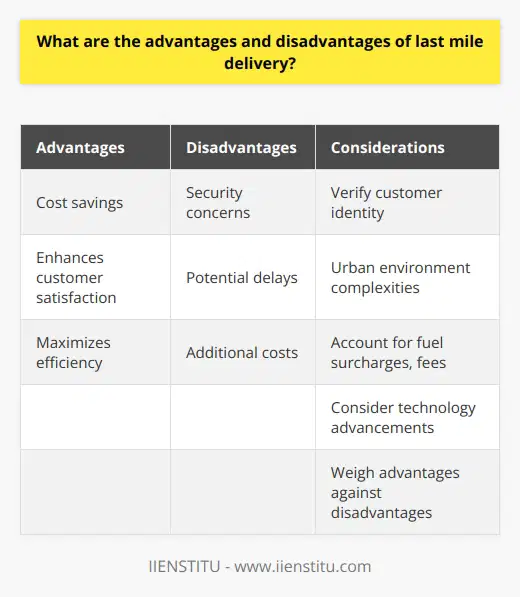
What challenges does last mile delivery pose to supply chain management?
Last-mile delivery is integral to supply chain management but presents several challenges. First, companies must ensure that goods are delivered on time and in good condition while minimizing cost and customer satisfaction. This requires careful planning, coordination, and a thorough understanding of the local environment.
One of the main challenges of last-mile delivery is the complexity of the distribution network. As a result, companies must ensure that goods are delivered to the customer most efficiently while avoiding costly delays. Additionally, multiple stakeholders are often involved in the delivery process, which can add to the complexity.
Another challenge is the increasing demand for faster delivery times. Customers have become accustomed to same-day delivery and expect goods to arrive promptly. As a result, companies must ensure that their delivery network can meet customer expectations. This often requires investing in new technologies and systems and clearly understanding the customer’s needs.
Finally, companies must ensure they can keep up with changing customer expectations. Customers’ preferences can change quickly, and companies must be able to adapt quickly to ensure customer satisfaction. This requires businesses to be agile and responsive to customer feedback.
Last-mile delivery poses several challenges to supply chain management, but opportunities exist. With careful planning and coordination, companies can ensure that goods are delivered on time and in good condition while minimizing cost and ensuring customer satisfaction. Additionally, companies can use new technologies and systems to adapt quickly to changing customer expectations. By understanding and addressing last-mile delivery challenges, companies can ensure that their supply chain remains efficient and responsive.
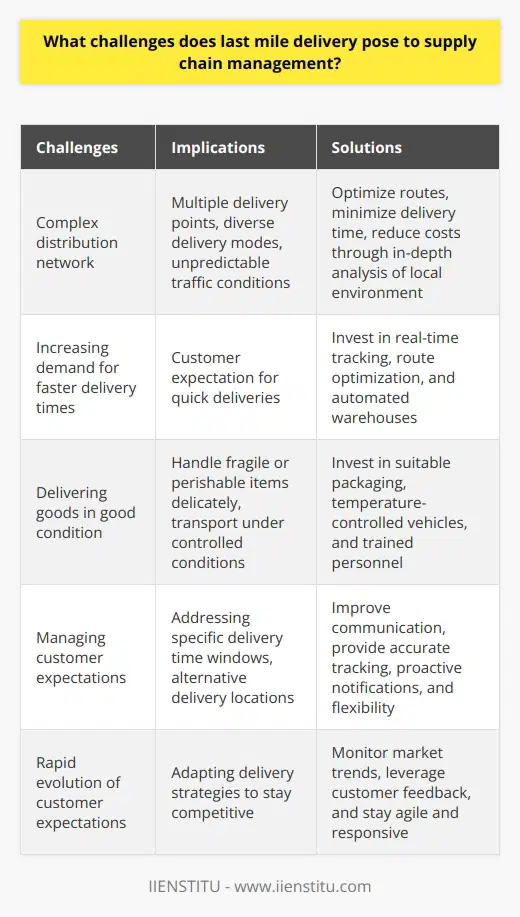
What innovations are being made in the area of last mile delivery?
The Last Mile Delivery process typically refers to the final stage of delivering goods from a distribution or fulfillment center to the end user. As online shopping and e-commerce continue to grow, there has been a corresponding increase in demand for more efficient last-mile delivery services. In recent years, numerous innovations have been made to improve this process.
One such innovation is the implementation of autonomous vehicles for last-mile delivery. Autonomous cars offer numerous advantages over traditional delivery methods, such as increased safety and reduced labor costs. Autonomous cars can also be programmed to navigate around obstacles and traffic jams, allowing them to reach their destination faster than human-driven vehicles. In addition, these vehicles are equipped with sensors that enable them to identify potential hazards before they occur, further enhancing their safety record.
Another innovation in last-mile delivery is using drones for package delivery. Using drones eliminates the need for physical transportation while providing an efficient and cost-effective way to deliver goods directly to customers' doorsteps. Additionally, drones can fly over obstacles such as buildings or traffic jams that may otherwise delay standard deliveries by road or air.
In addition to autonomous vehicles and drones, crowd-sourced delivery networks are another innovative approach to last-mile delivery. These networks allow customers to connect with local couriers who can transport goods from warehouses or stores directly to consumers' homes or businesses quickly and easily using their means of transportation. This approach offers several advantages over traditional methods, such as lower costs due to reduced overhead costs associated with hiring large fleets of drivers; it also provides increased flexibility as customers can specify pick-uptimes that are convenient for them rather than having goods delivered at predetermined times dictated by a third-party provider's schedule.
Finally, another emerging trend in last-mile delivery is the use of predictive analytics technology, which enables companies to predict customer demand better and optimize routes accordingly to ensure timely deliveries while minimizing costs associated with inefficient courses or missed opportunities due to unavailable resources at certain times within a given day's operations. By utilizing predictive analytics technology, companies ensure timely deliveries and reduce operational expenses associated with guessing when demand will spike, which reduces costs related to shipping and inventory management due to improved accuracy when predicting what items will be needed during peak periods.
In conclusion, numerous innovations have been made in last-mile delivery over recent years that have greatly improved efficiency and cost-effectiveness while reducing labor requirements associated with this process. Autonomous vehicles provide increased safety and speed; drones efficiently bypass obstacles; crowd-sourced networks allow consumers greater flexibility when ordering goods; and predictive analytics technology helps companies accurately predict customer demand, optimizing operations accordingly. By embracing these new technologies, companies can better position themselves for success in today's highly competitive market. Providing fast, reliable service has become increasingly important in driving customer satisfaction.
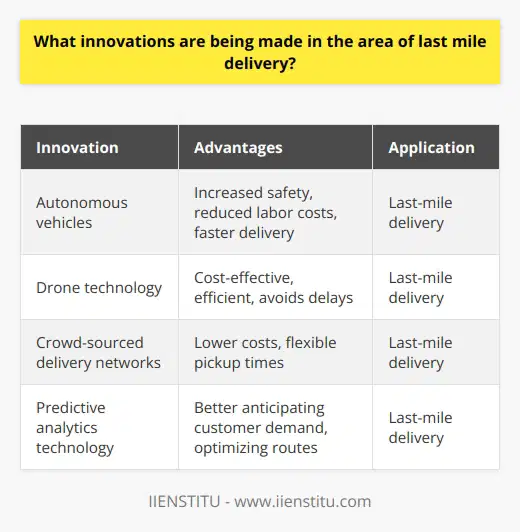
What are the challenges faced in last mile delivery?
Challenges in Last Mile Delivery
Efficiency and Speed
Efficient and speedy deliveries stand as a significant challenge in the last mile delivery process. Drivers often face traffic congestion, unexpected delays, and route inaccuracies, which impact overall efficiency and contribute to longer delivery times.
High Costs
Last mile delivery suffers from high costs stemming from fuel expenses, vehicle maintenance, and labor wages for drivers. Additionally, with the growth of e-commerce, demand for faster and more efficient delivery services further escalates these costs.
Managing Customer Expectations
Ensuring customer satisfaction can be a struggle as consumers demand more visibility and control over their deliveries. Meeting expectations for timely and accurate deliveries while also offering flexible options such as real-time tracking and flexible delivery windows remains a persistent challenge.
Delivery Density and Routing
In areas with lower delivery density, achieving cost-effective and efficient last mile deliveries can be problematic. Balancing the need for accurate and timely deliveries with covering many miles in sparsely populated areas results in increased operating costs and longer delivery times.
Infrastructure and Address Issues
Inadequate infrastructure, especially in rural or developing areas, presents a critical challenge in last mile delivery. Poor road conditions, challenging terrain, and ambiguous addressing systems make it difficult for drivers to locate customers and ensure successful deliveries.
Environmental Concerns
Growing concerns over environmental impacts, such as carbon emissions, pollution, and noise, have placed pressure on last mile delivery providers to adopt more sustainable and eco-friendly solutions. This necessitates investments in green technologies or infrastructure upgrades to meet evolving regulatory requirements.
Security and Theft
The risk of theft and security breaches continues to mount as e-commerce grows. Porch piracy, in which criminals steal packages left at a customer's front door, has become a serious challenge. Implementing secure delivery measures while fulfilling customer expectations remains a balancing act for last mile delivery providers.
In conclusion, the challenges faced in last mile delivery encompass efficiency, cost, customer satisfaction, density, infrastructure, environmental concerns, and security. Service providers must navigate these issues to offer effective, timely, and environment-friendly deliveries, all while ensuring customer satisfaction and remaining cost-efficient.
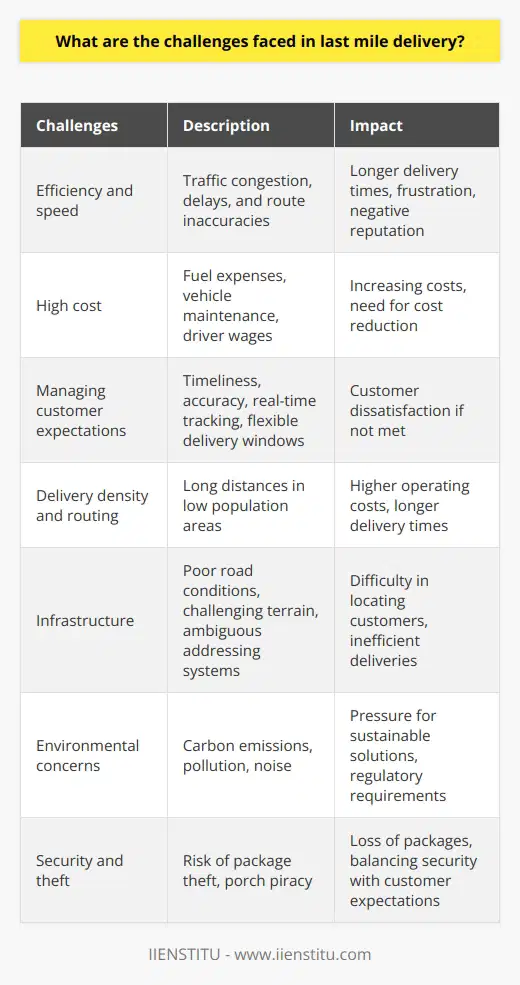
What is the advantage of last mile delivery?
Efficient and Timely Deliveries
One significant advantage of last-mile delivery is its ability to facilitate efficient and timely deliveries to customers. Last-mile delivery refers to the process of transporting a product from a distribution center to its final destination, which is typically a residential address or commercial location. By streamlining this crucial phase of the supply chain, businesses can ensure that their customers receive their purchases as quickly as possible, which is vital for maintaining customer satisfaction and loyalty.
Minimized Costs
Another benefit of optimizing last-mile delivery is the potential for cost reduction. Efficient routing enables delivery service providers to minimize the amount of fuel consumed and the time spent on each delivery. Moreover, fewer delivery attempts can lead to lower labor costs. When properly managed, last-mile delivery can significantly impact a company's bottom line while also offering a positive customer experience.
Increased Flexibility
Technological advancements have allowed for increased flexibility in last-mile delivery, contributing to the overall advantage of this process. For instance, incorporating real-time tracking and delivery updates enables customers to stay informed about the progress of their orders. This level of transparency strengthens the relationship between retailers and their customers and positions the retailer as an organization committed to meeting consumer demands.
Environmental Sustainability
Last-mile delivery can also promote environmental sustainability. By consolidating deliveries and implementing greener transportation options, such as electric vehicles or bicycle couriers, last-mile delivery can reduce emissions and contribute to a healthier planet. This is particularly important as many consumers become more conscious of the environmental impact of their purchasing decisions and expect companies to demonstrate a commitment to sustainability.
In conclusion, last-mile delivery offers numerous advantages for businesses, ranging from improving overall logistics efficiency and minimizing costs to increasing flexibility and promoting environmental sustainability. By investing in and optimizing last-mile delivery strategies, businesses can better fulfill customer expectations, build trust, and ultimately cultivate stronger connections with their target audience. This can lead to higher customer retention rates and increased revenue for the company.
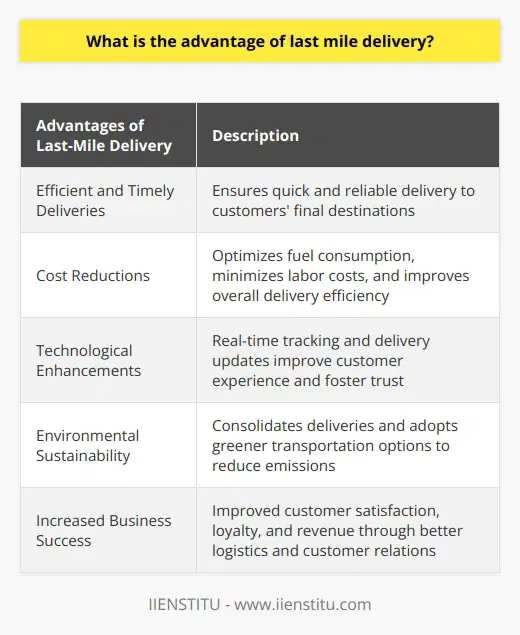
How do I manage my last mile delivery?
Efficient Route Planning
To effectively manage last mile delivery, start with efficient route planning. Utilize route optimization software to create optimal routes that consider various factors such as distance, time, and traffic. This ensures timely delivery and reduces fuel consumption, leading to cost savings.
Utilizing Technology
Invest in technology to improve overall last mile delivery management. GPS tracking devices help monitor delivery vehicles and adjust routes in real-time, while electronic proof of delivery systems enable quick and accurate recording of delivery completion. Implement mobile apps to update customers on delivery progress, enhancing customer satisfaction.
Outsourcing Delivery
Consider outsourcing last mile delivery to third-party logistics providers (3PLs), particularly in areas with high delivery volume or complex logistics. These companies possess specialized expertise and resources, enabling businesses to focus on their core operations while maintaining high-quality delivery service to customers.
Flexible Delivery Options
Offering flexible delivery options can simplify managing last mile logistics. By providing customers with choices such as pre-scheduled delivery time slots or designated pick-up points, businesses can accommodate a variety of needs while streamlining their delivery processes.
Effective Communication
Communication plays a crucial role in managing last mile delivery challenges. Train delivery personnel to interact professionally with customers, as they are the face of the company during the delivery process. Maintain open channels of communication between different departments, such as sales, customer service, and logistics, to ensure consistent delivery performance.
Data Analysis and Continuous Improvement
Analyze delivery data and customer feedback to identify opportunities for improvement. Measure key performance indicators, such as on-time delivery rates, number of returns, or delivery delays to evaluate the effectiveness of last mile delivery management. In turn, continually seek to enhance delivery processes and strategies based on data-driven insights.
In summary, managing last mile delivery requires a multifaceted approach that involves efficient route planning, technological investments, outsourcing when necessary, offering flexible delivery options, maintaining clear communication, and leveraging data for continuous improvement. By implementing these strategies, businesses can improve their last mile logistics management, ultimately contributing to enhanced customer satisfaction and overall operational performance.
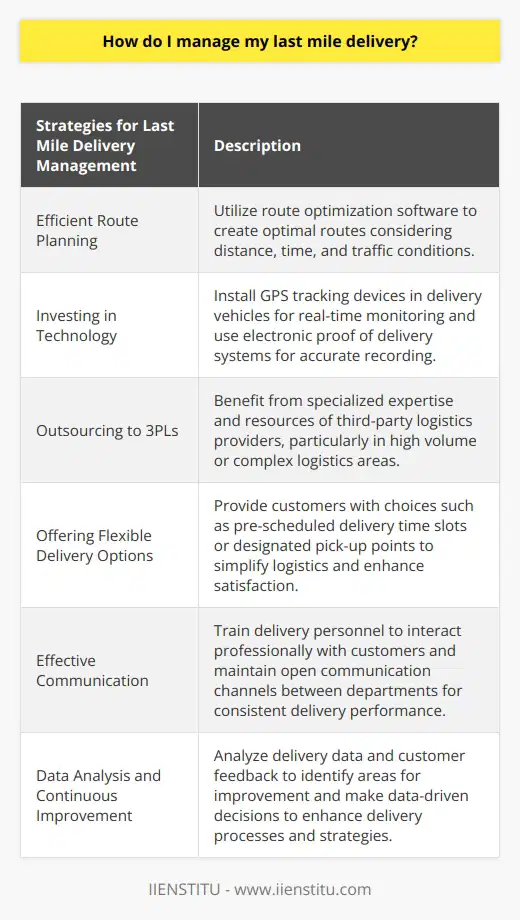
What are the key success factors for efficient last mile delivery?
Efficient Last Mile Delivery Strategies
Several key success factors contribute to the efficiency of last mile delivery, which has emerged as a critical aspect of contemporary logistics systems.
Collaborative Partnerships
One crucial factor is the establishment of collaborative partnerships between logistics providers, retailers, and customers. Strong communication channels facilitate better coordination and enable all parties to respond flexibly to any changes in delivery requirements or schedules.
Optimal Route Planning
Efficient route planning is also vital to last mile delivery success. Utilizing advanced optimization algorithms and real-time traffic data, logistics providers can plan and adjust routes to reduce transit time, minimize fuel consumption, and maximize resource utilization.
Advanced Technology Implementation
Adopting cutting-edge technologies, such as the Internet of Things (IoT), artificial intelligence (AI), and machine learning (ML), enhances the efficiency of last mile delivery. These technologies enable intelligent monitoring and predictive analytics, driving informed decision-making on route optimization, customer preference prediction, and inventory management.
Effective Same-Day Delivery Solutions
Same-day delivery services, particularly in urban areas, have become a crucial differentiator for retailers. By employing innovative solutions, such as micro-fulfillment centers, crowd-sourced delivery, and on-demand delivery platforms, businesses can offer customers faster order fulfillment while improving operational efficiency.
Proactive Communication with Customers
Transparent and proactive communication with customers is essential for an efficient last mile delivery experience. Customers should be provided with real-time tracking information, predictable delivery windows, and options to reschedule or reroute their packages. Addressing any issues promptly and efficiently enhances customer satisfaction and ultimately leads to customer retention.
Sustainable Practices Adoption
Lastly, embracing sustainable practices and technologies helps improve the efficiency of last mile delivery. Strategies include adopting electric or hybrid vehicles, implementing consolidated delivery solutions to minimize the overall number of trips, and using eco-friendly packaging materials. These approaches not only significantly reduce the environmental impact of last mile delivery systems but can also enhance companies' brand reputation and customer loyalty.
In conclusion, the key success factors for efficient last mile delivery include collaborative partnerships, optimal route planning, advanced technology implementation, effective same-day delivery solutions, proactive customer communication, and sustainable practices adoption. By addressing these critical elements, businesses can optimize their logistics operations and improve customer satisfaction, leading to increased growth and competitiveness in today's evolving market landscape.
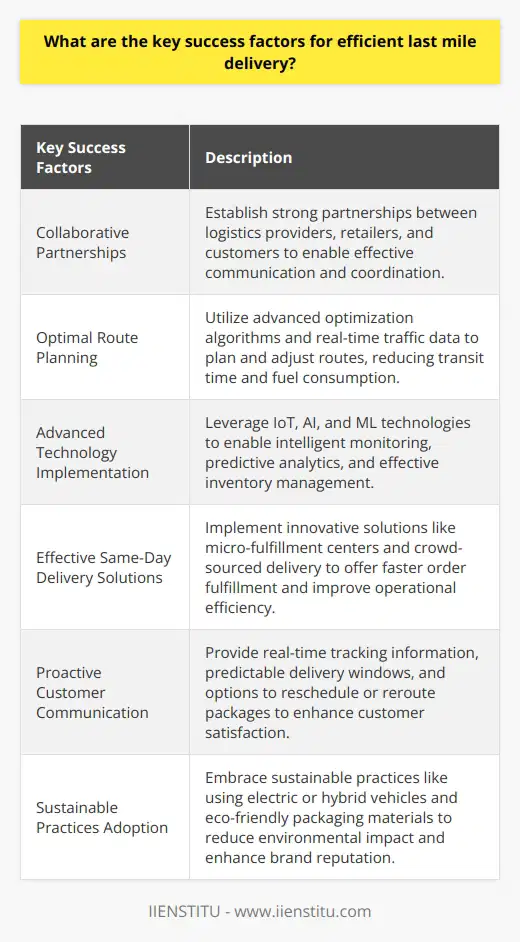
How can technology be utilized to optimize last mile delivery?
Optimizing Last Mile Delivery through Technology
Using Advanced Route Planning
Technology can greatly optimize last mile delivery by employing advanced route planning software. This allows for more efficient delivery routes, reduced time spent on the road, and decreased fuel consumption. As a result, companies can save money and deliver products to consumers more quickly.
Implementing Autonomous Vehicles
The integration of autonomous vehicles into last-mile delivery can potentially lead to significant improvements in efficiency and cost savings. Driverless delivery vans, drones, and robots are capable of operating 24/7, allowing for faster deliveries and reduced labor costs. Moreover, these automated devices minimize the risk of human error, further enhancing delivery accuracy and customer satisfaction.
Leveraging Real-Time Tracking and Communication
The use of real-time tracking technology enhances last-mile delivery optimization by providing customers with up-to-date information on the location and status of their packages. Additionally, communication tools allow delivery personnel to seamlessly connect with customers, ensuring a smooth pick-up or drop-off experience. This reduces instances of missed deliveries and promotes overall customer satisfaction.
Adopting Smart Lockers and Package Hubs
The utilization of smart lockers and package hubs in high-traffic, centralized locations can streamline last mile delivery. Customers can conveniently access these storage solutions at any time, eliminating the need for a delivery person to visit individual residences. This approach minimizes delivery attempts and reduces congestion in urban areas.
Incorporating Predictive Analytics and AI
Lastly, predictive analytics and artificial intelligence (AI) can be employed to forecast demand, track customer preferences, and anticipate order volumes. By understanding these trends, companies can allocate resources more efficiently, improve delivery routes, and better predict delivery times. Consequently, this leads to a seamless last mile delivery experience for both businesses and consumers.
In conclusion, technology plays a vital role in optimizing last mile delivery through advanced route planning, autonomous vehicles, real-time tracking, smart lockers, and predictive analytics. By incorporating these solutions, companies can achieve improved efficiency, reduced costs, and increased customer satisfaction.

What strategies can be employed to overcome the challenges in last mile delivery?
Addressing Urban Congestion
One strategy to overcome last mile delivery challenges is to address urban congestion, which typically hinders efficient delivery. Employing smaller vehicles or electric bikes can maneuver through congested areas more easily and reduce carbon emissions.
Utilizing Local Resources
Leveraging local resources allows for faster and more effective last mile delivery. By collaborating with local supply chain partners, local stores, and warehouses, delivery companies can optimize their network and reduce delivery time.
Integrating Technology
Digital innovation plays a crucial role in enhancing last mile delivery efficiency. Using advanced tracking systems, route optimization software, and real-time data analysis can help companies optimize their delivery routes, accurately predict delivery times, and manage customer expectations.
Implementing Crowd Shipping
Crowd shipping involves using non-professional drivers to deliver packages, thereby utilizing their already established routes. This approach can significantly reduce delivery costs and response times, while allowing for greater flexibility during peak delivery periods.
Offering Delivery Options
Providing customers with multiple delivery options, such as scheduled delivery, same-day delivery, or in-store pick-up, can help meet diverse customer demands. This results in higher customer satisfaction and increased delivery success rates.
Increasing Delivery Transparency
Enhancing communication with customers by providing real-time package tracking, estimated delivery times, and delivery alerts can help build trust and minimize delivery uncertainties. This ultimately leads to a more positive customer experience and a reduction in last mile delivery challenges.
Exploring Robotics and Drones
The use of robotic and drone technology is another strategy to address last mile delivery challenges. By automating various tasks, companies can reduce human intervention, increase efficiency, and minimize delivery time, while also addressing environmental concerns.
In conclusion, implementing a variety of strategies such as addressing urban congestion, leveraging local resources, integrating technology, utilizing crowd shipping, offering diverse delivery options, enhancing transparency, and exploring robotics and drone technology, can significantly improve last mile delivery. Utilizing these strategies can help companies overcome associated challenges and promote efficient delivery services, resulting in higher customer satisfaction and lower operational costs.
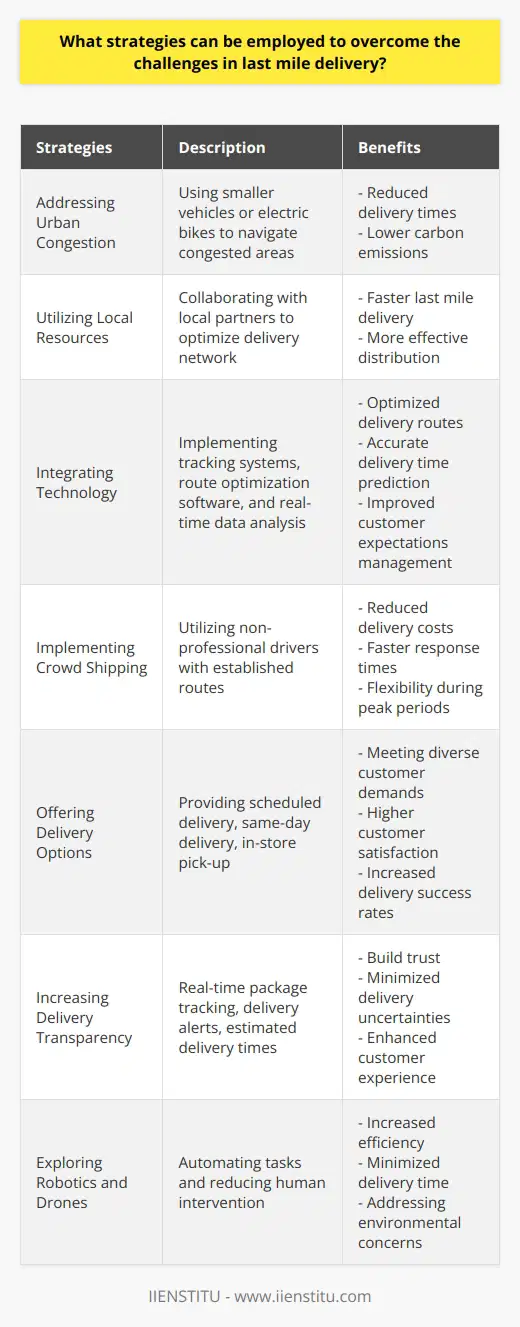
What are the biggest challenges relative to last mile deliveries for e-commerce?
Challenges in Last Mile Deliveries
Efficiency and Speed Constraints
The last mile delivery process poses several challenges for e-commerce companies, with efficiency and speed being the primary concerns. The effective and timely delivery of parcels is paramount in maintaining customer satisfaction, high service standards, and remaining competitive in the online market. Factors impacting the efficiency of these deliveries include the complexity of urban environments, route planning, and traffic congestion. E-commerce companies must find ways to minimize transit times and optimize delivery routes to overcome these issues.
Cost Management
Another major challenge is the management of delivery costs, which significantly impact the e-commerce profit margins. Companies must balance higher expenses, such as fuel, labor, and vehicle maintenance, with a need to provide an affordable or free shipping option for customers. Managing these costs while ensuring fast and reliable deliveries is a critical obstacle for last mile logistics.
Technological Integration
Integrating the latest technology into last mile logistics is essential for improving efficiency and reducing costs. However, adopting and implementing new solutions presents its challenges. Companies need the right tools to track and monitor parcels in real time, optimize delivery routes, and automate processes. Investment in technology is a critical step for e-commerce businesses, but it requires sufficient resources, expertise, and a clear understanding of the intended outcome.
Environmental Concerns
E-commerce companies are also under increasing pressure to reduce the environmental impact of their delivery processes. Online retailers must address air pollution, excessive energy consumption, and waste generated by packaging materials. To tackle these issues, businesses need to find ways to minimize the carbon footprint of delivery vehicles, utilize more sustainable packaging, and promote environmentally friendly practices.
Customer Expectation Management
Maintaining high levels of customer satisfaction during the last mile is another formidable challenge. Customers expect fast and convenient deliveries, with many demanding same-day or even within-hour options. To meet these demands, companies need to develop innovative and scalable solutions, such as drone deliveries or self-driving vehicles. Balancing customer expectations with delivery feasibility can be a difficult process.
In conclusion, last mile deliveries present e-commerce businesses with numerous challenges in efficiency, cost management, technological integration, environmental concerns, and customer expectation management. Companies must adopt innovative and sustainable solutions to overcome these obstacles and thrive in the competitive online market.
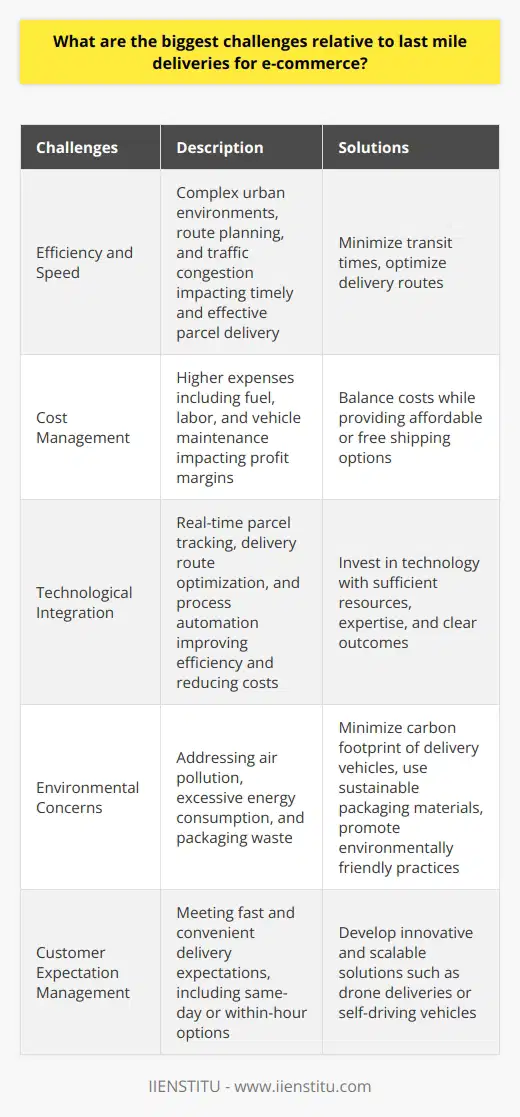
What are the benefits of last mile delivery tracking?
Benefits of Last Mile Delivery Tracking
Enhanced Customer Experience
One of the main advantages of last-mile delivery tracking is an improved customer experience. Consumers have real-time access to the status of their packages, reducing anxiety and promoting transparency. This fosters trust and loyalty, leading to repeat business and positive word-of-mouth marketing.
Optimized Routes and Delivery Efficiency
Last-mile delivery tracking allows companies to optimize their delivery routes by identifying bottlenecks and inefficiencies in their operations. Through data analysis, they can adjust routes and schedules, leading to fuel savings, reduced delivery times, and a decrease in operational costs.
Improved Communication with Customers
Last-mile delivery tracking enhances communication between businesses and their clients. Customers receive accurate information regarding their parcels' location and estimated arrival time, reducing the need for customer service inquiries. Businesses can proactively address delivery issues or delays, leading to higher customer satisfaction rates.
Reduced Lost or Stolen Packages
Package visibility through last-mile delivery tracking systems reduces the likelihood of lost or stolen packages, ensuring a secure delivery process. This not only protects your business from financial loss but also promotes customer confidence in your brand.
Inventory Management and Demand Planning
Last mile delivery tracking systems can provide valuable data on inventory movement, allowing businesses to effectively manage their inventory levels and predict future demand. This facilitates timely order replenishment, prevents stockouts, and enhances the overall supply chain efficiency.
In conclusion, last-mile delivery tracking offers numerous benefits in improving customer experience, delivery efficiency, communication, security, and inventory management for businesses. By implementing such systems, companies can gain a competitive edge in today's fast-paced e-commerce ecosystem.
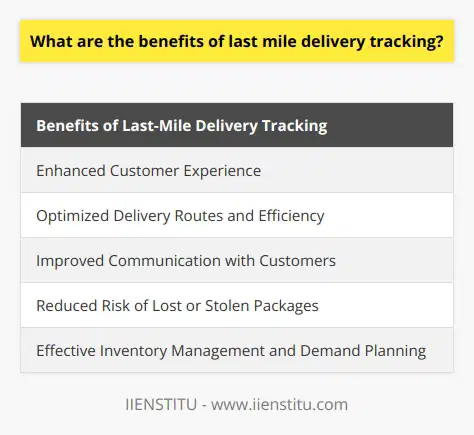
What are the key success factors for last mile delivery?
Key Success Factors for Last Mile Delivery
Optimized Route Planning
One of the most crucial factors for successful last mile delivery is optimized route planning. By utilizing advanced algorithms and data analysis, companies can create the most efficient delivery routes, resulting in reduced fuel consumption, minimized delays, and ultimately improved customer satisfaction.
Real-Time Communication
Last mile delivery thrives on real-time communication between delivery personnel and customers. Ensuring that the customer receives regular updates on their delivery status, along with the ability to track deliveries enables transparency and fosters customer trust. Furthermore, prompt communication between companies and their delivery personnel allows for seamless coordination and improved service quality.
Technology Integration
Integrating technology into last mile deliveries offers multiple benefits for both, companies and customers. Automated systems allow companies to manage the ever-growing complexity of supply chains, while enhancing consumer experience. Utilizing technologies, such as GPS tracking and route optimization software, not only drives cost efficiency but also caters to customer needs for convenience and visibility.
Customized Delivery Options
Understanding that each customer has unique preferences, providing a range of delivery options empowers customers with the flexibility to choose according to their needs. Offering services like same-day delivery, scheduled drop-offs, and locker pick-ups caters to various customer demands and helps improve overall satisfaction.
Skilled Workforce
A well-trained and skilled workforce is central to achieving success in last mile delivery. Developing a solid system of recruitment, training, and retaining workforce ensures that delivery personnel are knowledgeable, motivated, and capable of representing the company in a professional manner. Building a team equipped with the right skills and attitude leads to enhanced customer service and drives company growth.
Sustainability
Increasingly, companies are expected to demonstrate sustainable practices in their operations, including last mile delivery. Implementing eco-friendly solutions such as electric vehicles or cargo bikes, alongside optimizing route plans to minimize fuel consumption, fosters a green image and appeals to environmentally-conscious customers looking to make responsible choices.
In summary, last mile delivery success hinges on several key factors: optimizing route planning, maintaining real-time communication, integrating technology, offering customized delivery options, investing in a skilled workforce, and prioritizing sustainability. Companies that acknowledge and implement these elements are likely to excel in the realm of last mile delivery, satisfying customers and driving business growth in the process.
